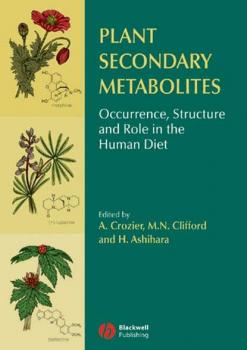ТОП просматриваемых книг сайта:
Alan Crozier
Список книг автора Alan CrozierАннотация
Plant secondary metabolites have been a fertile area of chemical investigation for many years, driving the development of both analytical chemistry and of new synthetic reactions and methodologies. The subject is multi-disciplinary with chemists, biochemists and plant scientists all contributing to our current understanding. In recent years there has been an upsurge in interest from other disciplines, related to the realisation that secondary metabolites are dietary components that may have a considerable impact on human health, and to the development of gene technology that permits modulation of the contents of desirable and undesirable components. Plant Secondary Metabolites: Occurrence, Structure and Role in the Human Diet addresses this wider interest by covering the main groups of natural products from a chemical and biosynthetic perspective with illustrations of how genetic engineering can be applied to manipulate levels of secondary metabolites of economic value as well as those of potential importance in diet and health. These descriptive chapters are augmented by chapters showing where these products are found in the diet, how they are metabolised and reviewing the evidence for their beneficial bioactivity.
Аннотация
Various plant metabolites are useful for human life, and the induction and reduction of these metabolites using modern biotechnical technique is of enormous potential important especially in the fields of agriculture and health. Plant Metabolism and Biotechnology describes the biosynthetic pathways of plant metabolites, their function in plants, and some applications for biotechnology. Topics covered include: biosynthesis and metabolism of starch and sugars lipid biosynthesis symbiotic nitrogen fixation sulfur metabolism nucleotide metabolism purine alkaloid metabolism nicotine biosynthesis terpenoid biosynthesis benzylisoquinoline alkaloid biosynthesis monoterpenoid indole alkaloid biosynthesis flavonoid biosynthesis pigment biosynthesis: anthocyanins, betacyanins and carotenoids metabolomics in biotechnology Plant Metabolism and Biotechnology is an essential guide to this important field for researchers and students of biochemistry, plant biology, metabolic engineering, biotechnology, food science, agriculture, and medicine.
Аннотация
In recent years, the role of plant secondary metabolites as protective constituents in the human diet has been a growing area of research. Unlike the traditional vitamins, they are not essential for short-term wellbeing, but there is increasing evidence that modest long-term intakes can have favourable impacts on the incidence of cancers and many chronic diseases, including cardiovascular disease and type II diabetes, which are occurring in Western populations with increasing frequency. This book covers the latest science on the metabolism and potential health benefits of teas, cocoa, coffee and their extracts in the human diet. From an opening chapter tracing the origins of teas, cocoa and coffee as beverage, the book proceeds to explore the phytochemical content of coffee, cocoa and the various types of tea. The bioavailability of secondary metabolites from each of the beverages is then considered in depth, and related directly to their health benefits. Embracing the full range of tea, coffee and cocoa beverages and products, the book offers the most up-to-date and comprehensive treatment of these increasingly important dietary components. As the only book to bring together the latest information on the biochemistry and health benefits of teas, coffee and cocoa, this book is essential reading for food scientists and technologists involved in the production of tea, coffee and cocoa products. Nutritionists will value the book's health focus, while agricultural scientists working on the cultivation of these crops will prize its scope and depth of detail. It is also an important resource for all those who use functional ingredients in other products, whether they are based in industry or research.



